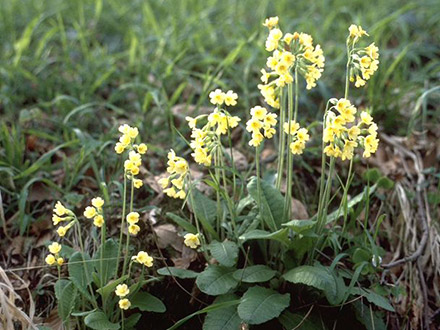Botanical name
Primula veris L.
Primula elatior (L.) Hill
Family
Primulaceae
Common name
Primrose, Cowslip, Oxlip
Information about the plant
With three different subspecies, the primrose populates the meadows and sparse shrubs over a large area from East Asia through Central and Middle Asia to Central Europe. It is not present in the north.
The botanical name Primula veris comes from the Latin "prima" (= the first) and "ver" (= the spring, gen. veris = of spring) and means "first small fruits of the spring", reflecting the fact that primrose is one of the first plants to flower in spring. In German, there is also the shortened name "Primel". "Cowslip" refers to the key-shaped flower form; until the 16th century, the plant was also known as the "key to heaven" because of the flower arrangement, which resembles a bunch of keys. It was believed that it could "unlock the heavens" through its healing properties.
The scapes, up to 20 cm high, spring up from a rosette of velvety hairy leaves. At the end, pleasantly fragrant flowers are arranged in an umbel. The sepals are fused into a tube, from which the yolk-yellow corolla with 5 lobes prominently protrudes. The scapes of the closely related P. elatior grow up to 30 cm tall; their corolla is pale yellow to sulphur yellow and does not have a scent. The flowering time of both species is from April through May.
Medicinally used parts of plants (herbal drug)
Both the dried rootstocks (rhizomes) with the attached 1 mm thick, long dried roots (primrose root - Primulae radix) and the dried flowers (Primulae flos) together with the calyxes (primrose flowers - Primulae flos cum calyce) are used. Both drugs can be obtained from P. veris and/or P. elatior. The drug from the root is supplied from the former Yugoslavia, Turkey, and Bulgaria.
Constituents of the herbal drug
Primrose roots contain triterpenoid and phenolic glycoside. Primrose flowers (primulas) also contain triterpenoid.
Quality of the drug
The quality of primrose root (Primulae radix) is specified in the European Pharmacopoeia (Ph. Eur.) and the quality of the following drugs or drug preparations is specified in the German Drug Codex (DAC):
- Primrose root tincture (Primulae radicis tinctura)
- Cowslip blossoms (Primulae flos cum calycibus)
Medical applications
Recognised medical use
The HMPC has classified primrose root and primrose flowers as traditional herbal medicinal products (see "Traditional use").
ESCOP: Primrose root: for coughs caused by colds; this indication is based on human experience and long-standing use.
Traditional use
The HMPC has classified primrose root and primula (primrose flowers) as traditional herbal medicinal products (Article 16a of Directive 2001/83/EC). Based upon long-standing use, primrose root and primrose flowers can be used as an expectorant for coughs associated with colds.
Herbal drug preparations in finished dosage forms
Primula root
- Cut primrose root as a tea
- Dried extract in capsules, tablets, and soluble instant teas
- Liquid extract in drops and juice
- Tincture in drops and solutions
- Thick extract in juice
- Primula flowers in tea blends
- Powdered primula flowers in coated tablets
Dosage
Finished medicinal product: see patient information leaflet.
Tea infusion: drink 1 warm cup of primrose root or primrose flower tea sweetened with honey every 2 to 3 hours as an expectorant. Daily dose of primrose root: 0.5 to 1.5 g of the drug; daily dose of primrose flowers: 2 to 4 g of the drug.
Preparation of a tea
Primrose root: 0.2 to 0.5 g of the finely cut drug is mixed with 150 ml of cold water, the mixture is brought to a boil, removed from the heat and strained after 10 minutes.
Primrose flowers: 150 ml of boiling water is poured over 1.3 g (1 teaspoon) of the drug and strained after 10 to 15 minutes.
Notes
No safety studies are available on the use of primrose root and primrose flowers during pregnancy and lactation. Not all primrose root preparations are suitable for children between 4 and 12 years of age (see patient information leaflet!). It is not advisable to use primrose root for coughs in children under 4 years of age, as these symptoms should be treated by a doctor; the use of primrose flowers in children under 12 years of age is not recommended due to a lack of evidence.
Side effects
None known.
Interactions
None known.
References
Herbal drug monographs
Further literature
Commentary on the European Pharmacopoeia (Primrose root, No. 1364)


